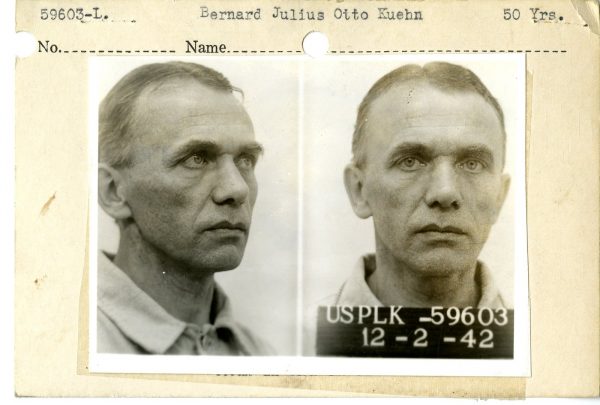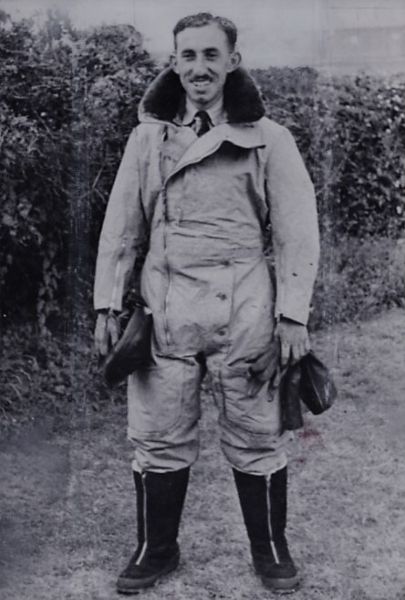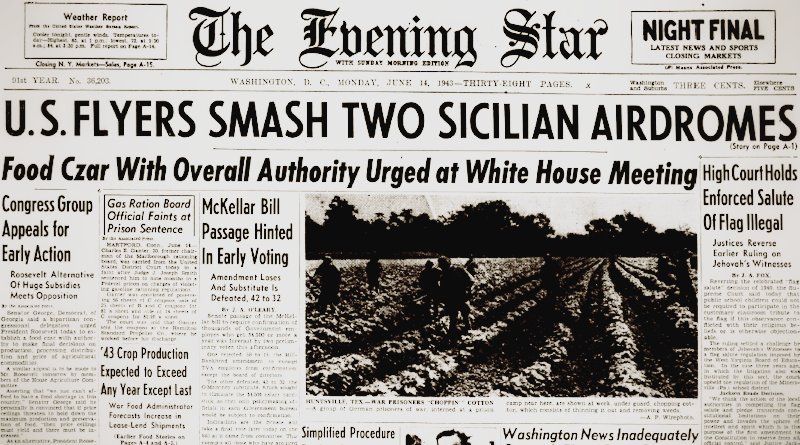World War II Chronicle: June 14, 1943
Click here for TODAY’S NEWSPAPER
On page two we see the mugshot of Bernard Julius Otto Keuhn, the man convicted for providing the Japanese with information on the American fleet at Pearl Harbor just prior to Dec. 7, 1941. Kuehn is a German national and member of the Nazi Party, and was originally sentenced to death by firing squad. However, he flipped and provided information on Axis intelligence rings, which changed his sentence to 50 years of hard labor. The FBI had been watching him since the 1930s, but they quickly grabbed him after the Japanese attacks. He is being held at the Army’s internment camp on Quarantine Island (Honolulu)…

Also on page two is a mention of Lt. Col. Benjamin O. Davis Jr.’s 99th Fighter Squadron. The Pantelleria air campaign was the Tuskegee Airmen’s first taste of combat… Pictured on page four is 1st Lt. Ralph C. Embrey, a fighter pilot who has just bagged his second German. Embrey will retire as a colonel and was the chief of staff of the Air Force Academy. His son Ralph II flew helicopters in Vietnam and was killed in action in 1970… On the same page, the Russians claim they have destroyed well over 3,000 German planes in a month and a half. You can’t trust much of what the Russians say, then or now. But the Germans are losing a lot of pilots and planes.
Digging into the numbers, all but five of the top 200 aces of the war are Germans.1Three Japanese Navy and two Finnish Air Force pilots make the list Thirty-five Luftwaffe airmen end up with 150 or more aerial victories. Fifteen surpass 200. Five have more than 250, and two top the 300 mark.
Three Soviet pilots score 60 or better. Just two top 50. 19 end up with 40 or more. I went to the trouble of trying to count the number of Luftwaffe pilots that had reached 60, 50, and 40 to see how they compared to the Soviets. I did not make it far because there are a LOT. Too many to continue, and when you figure that the Germans fought numerous air forces, it is hard to get a good comparison of pilot performance between Nazi Germany and the USSR. But the majority of the Luftwaffe’s victories are from the Eastern Theater.
Are the vast majority of these thousands of German planes being caught on the ground? Or is it just classic Soviet propaganda? I haven’t yet studied each side’s doctrine, but so far it appears that neither side rotated their best pilots away from the front line and into instructor roles to pass along crucial combat experience to students. Had we just left our top aces in the fight until they dropped or the war ended, American pilots would be a lot higher on the list. One factor is the improved F and FN models of the Lavochkin La-5 fighter made their combat debut this year for the Soviets. At low altitudes, the La-5F can rival its German counterparts. Ivan Kozhedub, who is considered the top Soviet ace of the war, has also just reached the front but he won’t begin notching victories until July…
On page five: the Italians garrison on Lampedusa was so eager to surrender they did so to a sergeant flying a biplane — who was trying to surrender to them. Sgt. Sidney Cohen was flying search and rescue mission in a Fairey Swordfish when his compass “got a case of the gremlins” and the Jewish pilot had to land at Lampedusa. Seeing Italians running out to meet him, he and his crew thought they were about to become prisoners. What they didn’t know was that the Italians had announced they were surrendering and thought he landed to accept their surrender. Now Cohen’s squadron mates now jokingly call “The King of Lampedusa.”

Page eight has a rather interesting advertisement by International Nickel Co. of helicopters… Sports section on page 14
Roving Reporter by Ernie Pyle
SOMEWHERE IN AFRICA — In the huge aerial crossroads camp that I wrote about yesterday, hundreds of black natives work — as houseboys, as white-coated waiters, as drivers, and as plain laborers putting up more buildings. They are descendants of the ones who escaped being carried away to America as slaves.
There is a negro houseboy for every two rooms in the officers’ blocks. He dresses in khaki shorts, and goes barefoot. His job is easy, but he has less “manana” in him than some of our own Latins.
The boys are faithful, honest and pleasant. Most of them are devoted to their masters. It will be hard for many an American officer to get over being waited on hand and foot when he returns to the old home town.
The houseboy comes at 6:30 in the morning, and stays till 6:30 at night. He has an hour off for lunch, and two hours for resting in the afternoon.
He keeps your room clean, airs the bedding, hangs out your clothes, and shines your shoes every day even if you haven’t worn them since the last shining. He does your washing if you don’t want to send it to the laundry, and sews on your buttons.
He is always within yelling distance somewhere on the back porch, and he comes at call to get you some ice or find you some matches or anything you wish.
He gets $13 a month salary, and each officer tips him 40 cents a week extra. The houseboy calls his officer “Master,” and sometimes it is slurred so that it sounds just like our oldtime southern negro “Massuh.” When our boy Jim first called me “Master” I thought he was talking to someone else, and looked around to see who was in the room.
The colored boys all speak a native tongue, but they know enough English that you can talk easily with them. In that area there is a whole vocabulary of pidgin English.
For instance you never heard the word “tip.” The word is “dash.” You “dash” your houseboy two shillings a week. A beggar never says “gimme.” He asks you to “dash” him a penny. A meal is “chopchop,” and when you’re telling a boy to do something immediately or to hurry, you say “one time.”
Another favorite expression is “Who dat man?” It seems that the native soldiers call halt by yelling “Who dat man?” So the thing has become a byword with our troops. If somebody knocks at your door, you call “Who dat man?” If a sinister villain appears in the movie to do the heroine dirt, the soldier audience yells “Who dat man?”
Around this special camp everything is made of mahogany. That doesn’t mean they’re squandering our taxes on foolish luxury; mahogany happens to be the cheapest and most prolific wood in those parts.
The clothes closets, the chairs, the weather stripping, the window sills are all of mahogany. This precious wood forms the rough benches of the outdoor movie. The projection shack is made of maahogany, and so are the concrete forms for the new buildings.
There is in fact so much mahogany everywhere that it almost ceases to be pretty, for after a while you just aren’t aware of it any more.
A small proportion of officers and men — maybe one-tenth on the hottest days — wears khaki shorts in Central Africa, just as tropical Englishmen do in the movies.
At night you are required to put on long trousers, long-sleeved shirts, and the officers must wear ties. It is as much for safety against mosquitoes as for discipline.
Also at night most people in camp wear mosquito boots — which are brownsuede, sort of like cowboy boots, nearly knee-high. In fact they won’t let you into the outdoor movie unless you’ve got on your mosquito boots.
The Army nurses have special boots which come clear above their knees. At least that’s what my investigating department reports.
Oddly enough, you don’t see many deep tans among our troops in the tropical countries. The reason being that you perspire so much you just soak the tan off.
Cigarettes get damp down there, and don’t taste the same. And you have to put your extra envelopes in the closet near the electric light. Otherwise they seal themselves. That’s the reason I don’t write to anybody; all my envelopes are sealed. Any old excuse in a storm, I always say.
Evening star. (Washington, D.C.), 14 June 1943. Chronicling America: Historic American Newspapers. Lib. of Congress.
https://chroniclingamerica.loc.gov/lccn/sn83045462/1943-06-14/ed-1/
